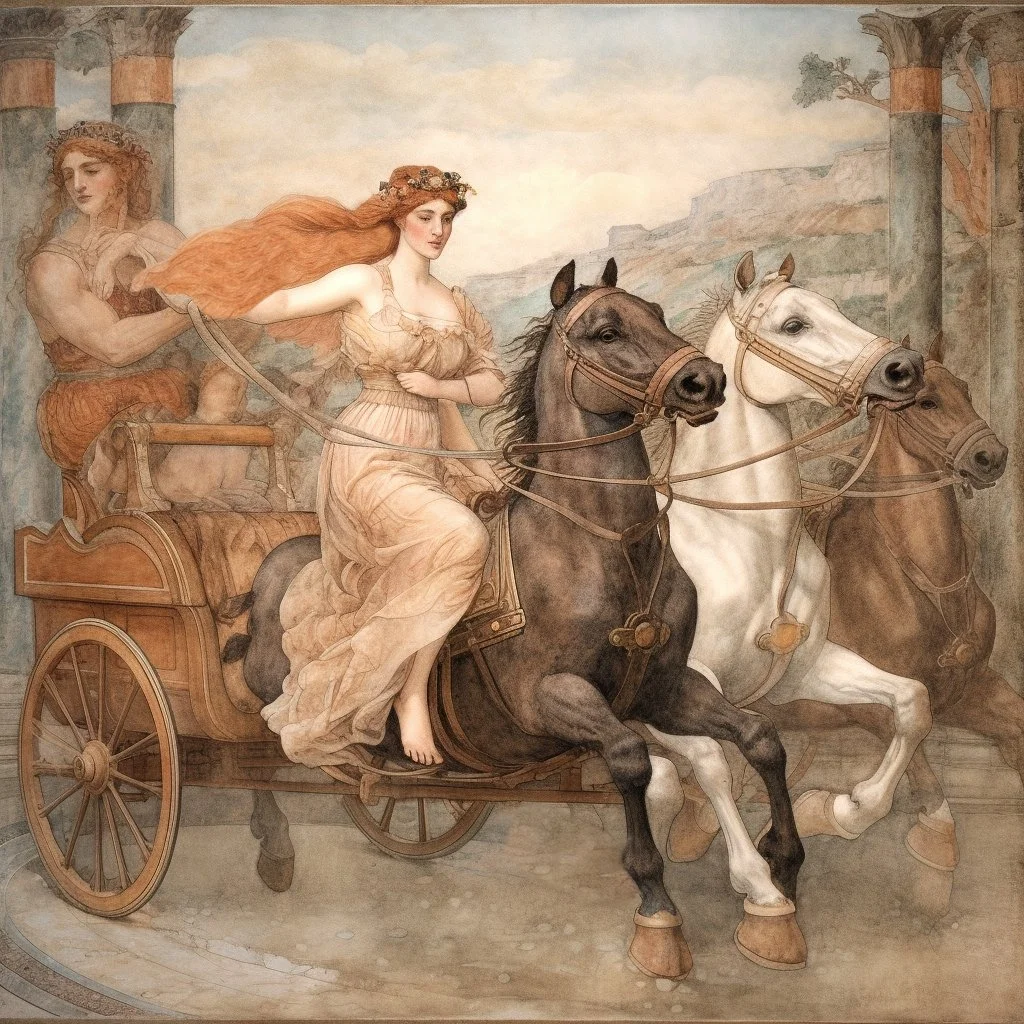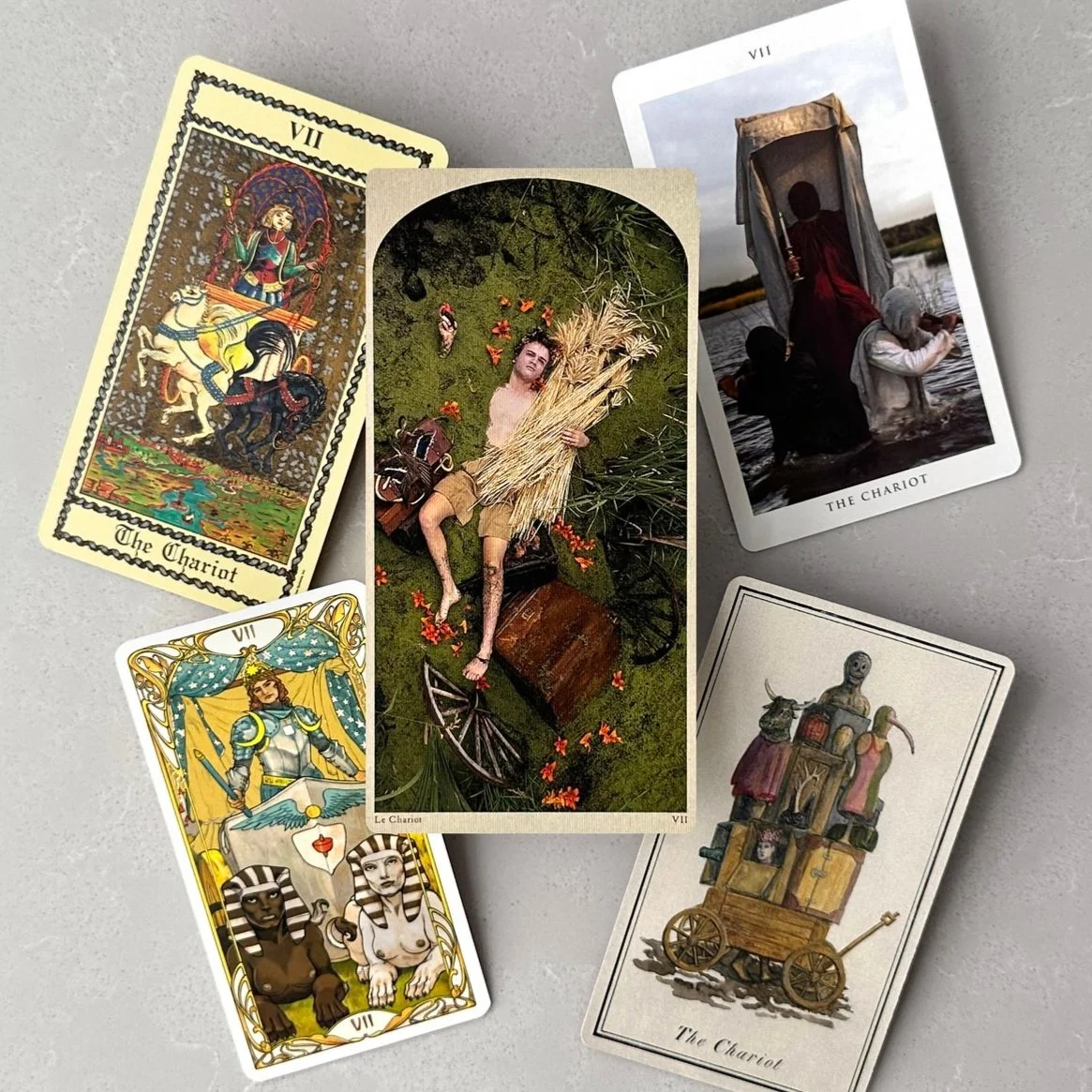Slow is smooth and smooth is fast
Understanding our own stride with The Chariot.
“Life moves pretty fast. If you don't stop and look around once in a while, you could miss it.” — Ferris Bueller
I have vivid childhood memories of my parents telling me to "slow down" on more than one occasion. Whether it was rushing through my homework to go outside and play, skipping steps in a new hobby I was trying for the first time, or devouring meals like a wild animal, I've always had a tendency to barrel through life at a somewhat erratic pace. While I can't pinpoint the root cause of this behavior now, as an adult, I have a better understanding of what Ferris Bueller meant when he delivered that iconic movie quote.
Around the same time, as I began studying the Tarot (I bought my first deck at the age of 12), I instinctively started slowing down to appreciate this new and burgeoning interest of mine. I wanted to dedicate quality time to each and every card, learning their imagery, symbols, colors, and, most importantly, their visual language. In some ways, these cards offered me a different kind of energy, one that had a focused direction and provided me with a more consistent means of regulating my speed. The United States Navy Seals have a saying, "Slow is smooth and smooth is fast," which is highly applicable to my Tarot journey and, to a larger extent, my life's journey. By slowing down and immersing myself in the study of the cards, I unleashed a spirited velocity that continues to accompany me to this day.
The Chariot created by artificial intelligence.
Card VII of the Major Arcana embodies obvious words like action, discipline, control, and acceleration—words that are often associated with the contemporary concept of success. Depending heavily on context, most of us are inclined to interpret this card with bold excitement, but at times we may overlook its quieter subtext. "Success" is a highly subjective term with as many interpretations as there are individuals on Earth (or those seeking a Tarot reading). And herein lies the complexity of The Chariot: success can be depicted with fanfare, passion, and extroverted energy, just as much as it can be represented with restraint, privacy, and introverted sensibilities. The Chariot serves as its own counterbalance, but as readers, it is up to us to intuitively discern not only the direction our driver is heading but also the speed at which they move.
To help us come to a better understanding of The Chariot I have selected five decks that help unpack its bold action, speed, and momentum, but also take into account the peaceful, tranquil, and docile moments it can also offer: the Golden Art Nouveau Tarot by Giulia F. Massaglia, The Medieval Scapini Tarot by Luigi Scapini, the Somnia Tarot by Nicolas Bruno, the Carnival at the End of the World Tarot, and The Tarot of the Drowning World—both by Kahn & Selesnick.
VII. The Chariot. Clockwise from top left: The Medieval Scapini Tarot by Luigi Scapini (U.S. Games Systems, Inc.), The Tarot of the Drowning World by Kahn & Selesnick, the Somnia Tarot by Nicolas Bruno, the Carnival at the End of the World Tarot by Kahn & Selesnick, and the Golden Art Nouveau Tarot by Giulia F. Massaglia (Lo Scarabeo)
First, let's begin with the card's namesake: the chariot. The chariot itself is the focal point in almost every depiction and is typically portrayed as a type of vehicle or wheeled cart pulled by two opposing forces, often represented as horses or sphinxes. The Golden Art Nouveau Tarot, The Medieval Scapini Tarot, and, for all intents and purposes, the Somnia Tarot, utilize these traditional symbols to signify progress or forward movement.
However, when examining the decks by the artistic duo Kahn & Selesnick, we are presented with a lack of these opposing forces. In the Carnival at the End of the World Tarot, we do encounter a "chariot," but it lacks an "engine." Instead, we see two small feet, presumably belonging to the young crowned man revealed in a box. This suggests that swift, forward motion depends on a lighter load, proper resource organization, and the foresight to chart the course. The creators of the deck pose the question: "What is the price to be paid for hastening a timetable and taking on baggage, and is there sufficient recompense upon arrival?" Similarly, in The Tarot of the Drowning World, not only are we without the balanced force that propels us forward, but it appears that we have crashed into a body of water. Perhaps this implies that if we are not truly balanced in the opposing forces that carry us on our journey, while simultaneously moving at a comfortable speed, control will ultimately be lost, leading to ruin.
The next obvious question we may have (especially if there has been a crash!) is, "Well, who's driving this thing?" The figure at the helm of the chariot is usually depicted as a crowned figure or a warrior, holding the reins and directing the path of the horses or sphinxes. Traditionally, the charioteer symbolizes willpower, self-control, and the ability to navigate through challenges and obstacles, as portrayed in both the Golden Art Nouveau Tarot and The Medieval Scapini Tarot.
However, upon closer inspection of both drivers in the Somnia Tarot and the Carnival at the End of the World Tarot, we notice that their views are obstructed. Whether it's a red fabric shroud or a brown cardboard box covering their heads, neither of these charioteers appears to have a clear sense of direction. However, effective drivers need to rely on their other senses to find a way forward. A keen sense of hearing or smell can also guide the way. While having all senses working together to make sound decisions is ideal, the success of a journey ultimately depends on the sharpness of the individual in the driver's seat.
If a few of these charioteer's senses have been compromised, what other external indicators would these characters be inclined to use? Although today's navigation methods rely on advanced technology, the stars in the sky continue to hold significance as a timeless symbol of guidance and direction. The stars visible in the canopy of the chariot provide the same guidance. Yes, they may be stationary and offer no guidance in the physical realm, but in the Tarot, they serve as a representation of creative and visionary energies. Stars inspire the charioteer to dream, set goals, and strive for their own version of excellence.
But the themes of intuition and higher knowledge take different forms in a few depictions of The Chariot. For example, the drowning driver in The Tarot of the Drowning World Tarot is surrounded by orange lilies against the mossy surface of the water. Although his journey came to an abrupt (and potentially chaotic) end, at least he attempted the journey with a sense of confidence, represented by these flowers. As Winston Churchill once said, "Success is not final, failure is not fatal: It is the courage to continue that counts."
Similarly, without any stars to help navigate, we turn to the lit candle held by the driver in the Somnia Tarot's card as a substitute for inner wisdom. In the Tarot at large, wands, staffs, or scepters symbolize leadership with a sense of purpose and direction. Does this mean that this charioteer doesn't need the stars? Perhaps. But more importantly, the flame signifies that they haven't lost their way, even though they've lost their sight.
The Chariot gives shape to the personalized concept of success, emphasizing the need for balance and direction on our individual journeys through life. By heeding the advice of my parents (and Ferris Bueller), slowing down allows us to fully focus on the journey and, more importantly, grants us the ride of our lives.


